There’s been a seismic shift in the way men approach fitness over the past few years. With pandemic restrictions, rising gym membership costs, and the convenience of at-home setups, home gyms have moved from niche luxury to mainstream necessity. But beyond convenience, why are so many guys trading in their commercial memberships for garage benches and basement racks?
First, there’s the flexibility. Home gyms let you train on your time—no waiting for equipment, no closing hours, and certainly no commute. Want to bang out a session at 5 AM before work or squeeze in a workout after dinner? Done. You’re in charge of your fitness schedule.
Then there’s the customization factor. In a home gym, you’re the boss. Prefer a barbell over a dumbbell? Hate cardio machines? Want motivational quotes on the wall? You get to shape the environment to your needs. That sense of ownership often drives greater consistency and commitment.
And let’s be honest—gym intimidation is real. For beginners or even seasoned lifters, commercial gyms can feel like performance arenas. At home, there’s no one watching, no ego lifting, and no distractions. It’s just you and your goals.
Advantages Over Commercial Gyms
The perks of a home gym go way beyond just skipping the locker room. Let’s break it down:
- Cost Efficiency Over Time: While the initial investment might seem high, it’s often cheaper in the long run. Think about it: no monthly fees, no gas, no overpriced shakes. Over a few years, your home gym pays for itself.
- Hygiene and Safety: You control the cleanliness. No more sweaty benches, overused equipment, or questionable sanitization. Plus, there’s no sharing during cold and flu season.
- Focus and Consistency: Distractions at the gym can derail your momentum—waiting for equipment, chatting with acquaintances, or dealing with gym culture. At home, it’s pure focus.
- Privacy and Personalization: Whether you’re blasting your favorite playlist, training shirtless, or practicing new lifts, you do it your way, in your space.
- Time-Saving: Let’s not underestimate the power of time. No travel. No waiting. Just walk into your garage or spare room and get to work.
Of course, it’s not all sunshine—building a home gym takes planning and discipline. But with the right mindset and setup, the payoff is enormous.
Planning Your Home Gym

Defining Your Fitness Goals
Before buying that squat rack or setting up a yoga mat in the corner, you need to get clear on one crucial thing: What do you actually want to achieve?
Your goals determine everything—equipment, space, budget, and workout design. Are you looking to pack on muscle? Burn fat? Improve overall health? Train for a sport? Or maybe it’s a mix?
Let’s say your aim is hypertrophy—building muscle mass. That means you’ll need access to resistance training tools like dumbbells, barbells, or resistance bands. If fat loss and cardiovascular health are your goals, you might prioritize a rowing machine or a jump rope.
Maybe you’re chasing athletic performance. Then your setup might lean into plyometrics, agility equipment, or even turf.
Write down your goals—yes, physically write them. Break them into short-term (90 days), mid-term (6 months), and long-term (1 year+) targets. This keeps you focused and helps track your progress. And don’t be vague. “Get fit” isn’t a goal; “lose 10 lbs and deadlift 300 lbs by Christmas” is.
Also, think about your training preferences. Do you enjoy bodyweight workouts, heavy lifting, HIIT, or a mix of all three? A gym that aligns with your interests keeps you consistent.
Understanding your goals not only shapes your gym but also acts as your compass whenever motivation wavers.
Assessing Available Space
Let’s be real—not everyone has an empty garage or finished basement to dedicate to a gym. But the good news? You can create a solid home gym in any space if you plan smart.
First, evaluate what you’re working with: garage, spare bedroom, basement, patio, or even a corner of your living room. Measure the dimensions and ceiling height. These details matter big time when choosing equipment.
Then think vertically and modularly. Wall-mounted racks, foldable benches, and stackable weights are great for tight spaces. Mirrors can make smaller areas feel bigger, while proper lighting enhances the vibe.
Don’t forget about flooring. Whether you’re dropping heavy weights or just doing burpees, quality gym mats protect your home and your joints.
Lastly, consider accessibility. Can you easily get to the space? Is it comfortable year-round? If it’s a garage, will it be too hot in the summer or freezing in the winter? Temperature control can make or break consistency.
Budgeting for Your Home Gym
Your budget is the backbone of your home gym project. But here’s the thing—it doesn’t have to cost a fortune. You can build a powerful, functional gym for less than a few months’ worth of a premium gym membership.
Start by separating needs from wants. Essentials might include a barbell, plates, adjustable bench, and dumbbells. Wants? Maybe a power rack, treadmill, or cable machine. Prioritize based on your goals.
Expect to spend:
- $300–$500: Basic setup (resistance bands, adjustable dumbbells, yoga mat, jump rope)
- $500–$1000: Intermediate (bench, squat rack, barbell, some plates)
- $1000+: Full gym setup (all of the above plus cardio machines and specialty gear)
Don’t sleep on second-hand deals. Craigslist, Facebook Marketplace, and used fitness stores are gold mines. You can often score commercial-grade gear for a fraction of retail prices.
And remember—buying quality now saves money later. Cheap equipment breaks, rusts, or underperforms. Invest smart and build over time.
Must-Have Home Gym Equipment for Men
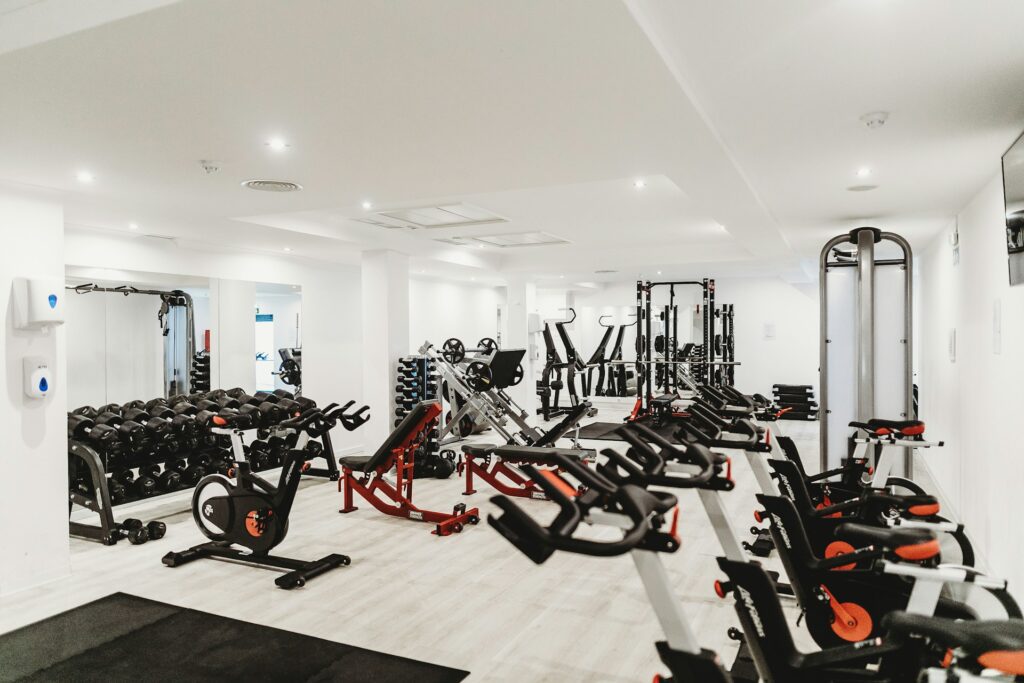
Strength Training Essentials
When it comes to building a serious home gym, strength training equipment should be at the top of your priority list. This gear forms the foundation for muscle-building, fat-burning, and overall fitness.
Let’s start with the king of all strength gear: the barbell. A standard Olympic barbell, paired with weight plates, is incredibly versatile. Squats, deadlifts, bench presses, rows—you name it. This single piece of equipment can work your entire body. Aim for a 7-foot bar that supports up to 500 pounds minimum.
Next up: adjustable dumbbells. If you’re tight on space, these are a godsend. Instead of cluttering your space with 10 pairs, get one pair that covers 5 to 50+ lbs. Brands like Bowflex, PowerBlock, and Ironmaster offer solid choices.
Don’t overlook the adjustable bench. Flat benches work, but one that inclines, declines, and adjusts to various angles allows more exercise variation—crucial for hitting muscles from all angles.
Now, if you have the room and budget, consider a power rack or squat rack. This lets you safely perform squats, bench presses, and overhead lifts, often with built-in pull-up bars or cable attachments. It’s your all-in-one strength station.
Other essentials:
- Kettlebells (great for swings, presses, and conditioning)
- Resistance bands (perfect for warmups, accessory work, or adding resistance)
- Pull-up bar (if not already included in your rack)
With just these basics, you can train every muscle group and progress for years. The trick is to invest in durability and versatility—because every dollar should work as hard as you do.
Cardio Equipment Choices
Cardio isn’t just about weight loss—it improves heart health, boosts endurance, and aids in recovery. So even if you’re a strength purist, some form of cardio gear should be in your home gym.
If you’ve got the budget and space, a treadmill or spin bike is an obvious choice. High-end models offer built-in training programs, heart rate tracking, and immersive workouts. But what if you’re working with a smaller budget?
Enter the rowing machine. Rowers are one of the most efficient full-body cardio tools out there. They target your legs, back, core, and arms—while torching calories. Compact, easy to store, and low-impact, they’re a great alternative to high-impact treadmills.
Another underrated option: air bikes (assault bikes). These beasts combine upper and lower body work and scale with your effort, making them great for HIIT workouts.
And of course, jump ropes. Cheap, portable, and brutally effective. Mastering jump rope technique can skyrocket your conditioning.
For low-cost, space-saving cardio:
- Stair stepper or mini step machine
- Speed ladder for agility work
- Heavy bag for boxing or kickboxing (cardio + stress relief)
Cardio equipment doesn’t have to be boring or bulky. The key is finding what you’ll actually use—because the best cardio machine is the one you keep coming back to.
Accessories That Elevate Workouts
Once you’ve got your core gear, it’s time to add those small but mighty tools that take your home gym—and your gains—to the next level.
Foam rollers and massage balls are game-changers for recovery. Use them to release muscle tightness, improve flexibility, and prevent injuries. If you’re lifting heavy, mobility matters.
Lifting belts, wrist wraps, and knee sleeves are accessories that serious lifters rely on for support and injury prevention. Not everyone needs them from day one, but as your weights go up, so does the need for support.
Add a set of gymnastic rings or TRX straps for bodyweight workouts that build functional strength and core stability. These can hang from a power rack, ceiling mount, or even a sturdy door frame.
Timers and wall clocks are often overlooked but essential. Interval training, rest management, or just staying on track—it all runs smoother with a good timer.
Don’t forget the power of sound. A Bluetooth speaker or wireless headphones keeps you pumped. Your playlist, your vibe, your pace.
Other worthy additions:
- Chalk or lifting grips for improved grip
- Dip bars or attachments for triceps and core work
- Ab wheel for killer core training
- Resistance sled or sandbag for conditioning
These accessories might seem small, but they make a big impact. They help you train smarter, recover faster, and stay motivated longer.
Creating a Workout-Friendly Environment
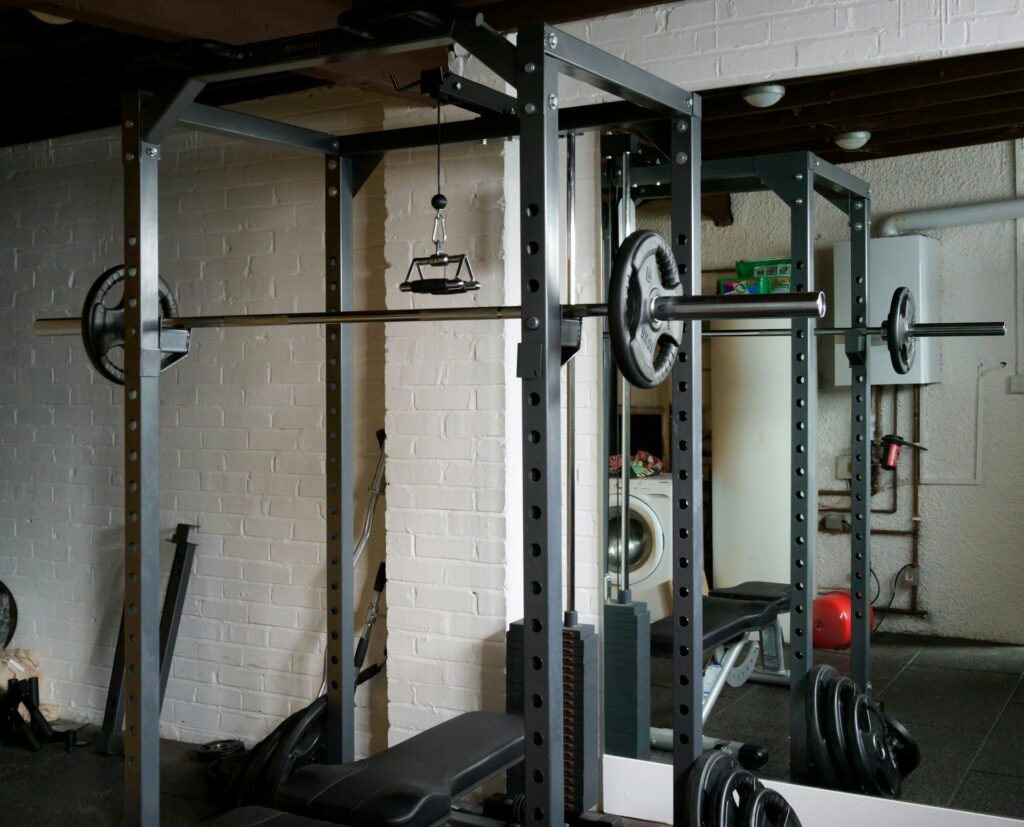
Flooring and Acoustic Considerations
Let’s face it—dropping weights on tile or carpet isn’t just loud, it’s dangerous and damaging. Proper flooring is one of the most overlooked parts of a home gym, yet it’s crucial for protecting your floor, your equipment, and your joints.
Your best bet? Rubber flooring. Interlocking rubber mats or rubber rolls are easy to install, durable, and shock-absorbent. Look for commercial-grade ¾-inch mats, especially if you’re using heavy weights or machines.
If you’re lifting in a garage, horse stall mats from farm supply stores are a cost-effective and tough solution. They’re heavy, grippy, and can handle barbell abuse without complaint.
Noise can be another issue—especially in apartments or shared homes. To dampen sound, add:
- Foam tiles or acoustic panels on walls
- Drop pads or crash mats for deadlifts
- Thick yoga mats under machines
Aside from noise, consider foot traffic. You want flooring that’s easy to clean (because you will sweat buckets) and resistant to wear.
If you’re doing cardio or jumping exercises, your joints will thank you for investing in shock-absorbing materials.
Proper flooring turns any space into a legitimate training zone—safe, silent, and solid.
Lighting and Ventilation Tips
A dark, musty space doesn’t exactly scream motivation. You want your gym to feel like a place you want to be in. And that starts with light and air.
First, tackle lighting. If your gym is in a basement or garage, natural light may be limited. Install bright LED overhead lights—ideally daylight bulbs in the 5000–6000K range—to mimic sunlight and keep energy high.
Accent lighting, like strip LEDs behind mirrors or equipment, adds flair and can help create a high-end look without much cost.
Now ventilation. No one wants to train in a sweaty, stale environment. Invest in:
- Fans or air circulators (ceiling fans if possible)
- Portable AC units or heaters, depending on your climate
- Dehumidifiers if your gym is in a humid basement
- Open windows or ventilation ducts to promote airflow
Odor control is key too. Use air purifiers or even essential oil diffusers (peppermint is great for energy). Your gym should feel clean, breathable, and inviting.
A well-lit, well-ventilated gym isn’t just about comfort—it directly impacts your energy, performance, and willingness to train consistently.
Mirrors, Motivation, and Decor
You may think mirrors are just for posing—but in a home gym, they’re a functional necessity. Mirrors help you monitor your form during lifts, ensure alignment during stretches, and even create the illusion of a larger space.
Mount a full-length mirror on at least one wall. If space allows, go bigger. More visibility equals better training.
Now let’s talk motivation. This is your sanctuary—make it inspiring. Add posters, vinyl wall quotes, or vision boards with your fitness goals. Whatever gets you fired up.
Decor doesn’t have to be fancy, but it should reflect you. Whether it’s vintage bodybuilding posters, your favorite sports team, or sleek minimalist design—make it a place that feels uniquely yours.
Also consider functional decor:
- Whiteboard or chalkboard for writing workouts
- Storage racks that double as design pieces
- Trophy shelves or PR boards to celebrate milestones
This environment will shape your mindset every time you walk in. Make it a space that pushes you to be better—day in, day out.
Setting Up Your Gym Layout
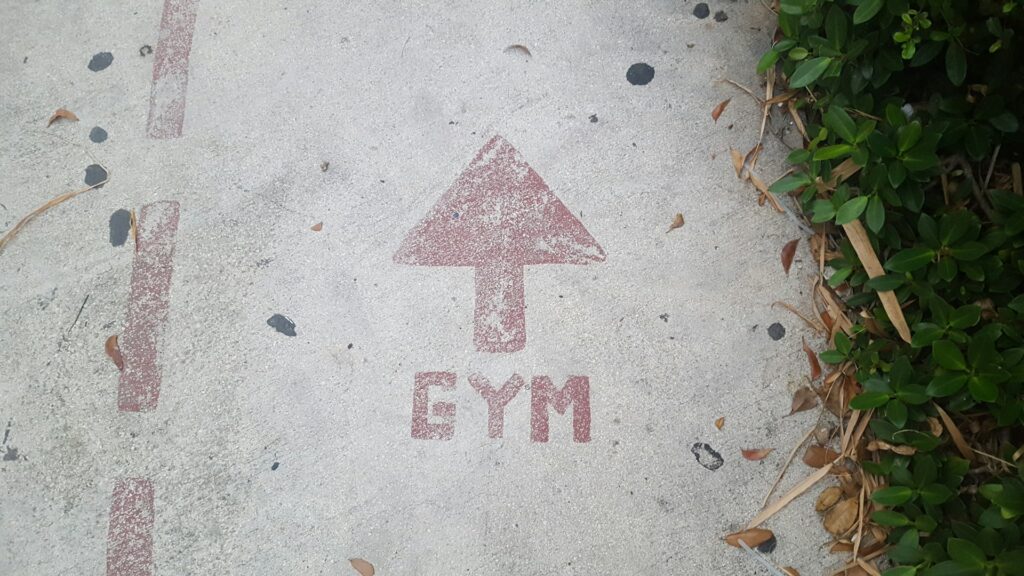
Optimizing Space for Functionality
When it comes to building an efficient home gym, layout is everything. Think of your gym space as a battlefield—each piece of equipment should have a clear purpose and position. Whether you’re working with a single-car garage or a spacious basement, optimizing space ensures seamless transitions, better safety, and higher motivation.
Start by zoning your gym into different “stations”:
- Strength zone: for squats, bench presses, dumbbell work
- Cardio zone: for rowers, bikes, or treadmills
- Stretching/recovery zone: a corner with a mat, foam roller, and mobility tools
Place your heaviest equipment (like a power rack or bench) against the sturdiest walls or in the center if they anchor your workouts. Machines should sit flush with the walls to preserve floor space. Use vertical space for storage—install wall-mounted racks for barbells, dumbbells, bands, and accessories.
Make sure there’s at least 3–4 feet of clear space around your lifting area. You need room to move freely and safely. Position cardio machines near ventilation or windows if possible—trust me, you’ll appreciate the breeze during a HIIT sprint.
Mobility is key. You should be able to move from one station to another without stepping over equipment or shuffling mats. Keep paths clear and clutter-free. Storage solutions like vertical shelving, rolling carts, and under-bench bins are a game-changer for maintaining order.
A functional gym isn’t just about what’s in it—but how it all fits together. A clean, logical layout helps you train harder, safer, and more consistently.
Safety and Accessibility Planning
Let’s get serious for a minute—safety isn’t optional in a home gym. When you don’t have a spotter or staff nearby, it’s on you to make sure your space is built for safe solo training.
Start with your flooring again: non-slip, shock-absorbent surfaces reduce the risk of slips, falls, or joint stress. Make sure everything is level. Wobbly benches or uneven mats are accidents waiting to happen.
Next, anchor your heavy equipment. Racks, cable towers, and wall-mounted systems should be bolted down if possible. If you’re using a free-standing rig, check that it’s stable before every session.
Install proper lighting in all corners. Shadows can hide hazards or mislead your form in the mirror. Bright, consistent lighting helps you see clearly and train confidently.
Storage matters for safety too. Tripping over a rogue kettlebell or tangled resistance band is the stuff of injury nightmares. Use racks, wall pegs, or bins to keep things off the floor when not in use.
If you’re lifting heavy, invest in safety arms or spotting equipment for your power rack. Don’t risk getting pinned under a barbell alone.
Keep a first aid kit nearby with basics: bandages, wraps, antiseptic, and ice packs. You won’t need it often—but when you do, you’ll be glad it’s within arm’s reach.
Finally, if your gym is in a shared home, make sure others know when you’re training. A simple “gym in use” sign can avoid interruptions and distractions.
Safety and accessibility aren’t flashy, but they’re essential. A well-prepared space lets you push limits confidently—without risking injury or chaos.
Cost-Effective Tips and DIY Solutions

Building Equipment from Scratch
If you’re working with a limited budget, building your own gym equipment can save you hundreds—sometimes thousands—of dollars. DIY solutions aren’t just cost-effective; they also let you customize gear to fit your space and training style.
One popular DIY project is a plyometric box. With some plywood, screws, and a drill, you can create a durable box for step-ups, box jumps, or Bulgarian split squats. Add rubber on top for grip.
Another project? Parallettes or push-up bars. Using PVC pipes and connectors, you can create stable bars for push-ups, L-sits, and dip variations for a fraction of store prices.
Many men have even built their own squat racks using 4×4 lumber, steel pipe, and concrete for base stability. It requires basic tools and a weekend of work, but you’ll end up with a fully functional rig.
Need weights? Fill buckets with sand or concrete, or use old tires and fill them with cement. Add handles, and you’ve got makeshift kettlebells or weight plates.
For resistance bands, get bike inner tubes from a repair shop—they work surprisingly well for mobility or light resistance work.
Just make sure any DIY equipment is tested for stability and safety. Reinforce everything, test before heavy use, and don’t skimp on materials where it matters.
DIY isn’t just about saving cash—it’s about putting sweat equity into your space and making it truly yours.
Second-Hand Bargains and Deals
One of the smartest ways to stock your gym is buying second-hand. Why pay retail when you can score commercial-grade equipment for half the price?
Start with local classifieds like Craigslist, Facebook Marketplace, OfferUp, and Letgo. People constantly offload gear after failed New Year’s resolutions or garage cleanouts.
Look for:
- Barbells and bumper plates
- Adjustable dumbbells
- Benches and squat racks
- Cardio machines (treadmills, bikes)
Before buying, inspect the equipment. Check for rust, wear, missing bolts, or structural damage. Don’t hesitate to ask for a demo or try it out yourself.
You can also hit up:
- Used gym equipment stores
- Pawn shops
- Garage sales
- Auction websites like GovDeals or public surplus platforms
Set up alerts for certain keywords and be ready to jump on a deal. Good equipment moves fast.
And remember—brand names matter. Rogue, Titan, Bowflex, and Rep Fitness gear holds up over time. Even used, they’re usually worth the investment.
Buying second-hand isn’t just frugal—it’s eco-friendly and often gives you access to higher-quality gear you couldn’t otherwise afford.
Subscription Services vs. Free Resources
When it comes to programming, coaching, and workout videos, you’ve got tons of options—free and paid. The question is, which is right for you?
Free resources:
- YouTube channels (ATHLEAN-X, Buff Dudes, Jeff Nippard, etc.)
- Reddit fitness communities
- Free apps like Nike Training Club or FitOn
- Instagram trainers and influencers
These are great for getting started or staying inspired. But they often lack structure and personalization.
Subscription services, on the other hand, offer progressive programming, coaching support, and performance tracking. Examples include:
- Fitbod: AI-generated home workout plans
- Centr by Chris Hemsworth: Includes workouts, recipes, and mindfulness
- Train Heroic or Juggernaut AI: Powerlifting and strength-focused plans
Costs range from $10–$50/month. Not cheap, but if it keeps you consistent and progressing, it’s a worthy investment.
Best bet? Start with free resources, then upgrade once you know your needs and training style. Don’t pay until you’re ready to use it fully.
Upgrading and Scaling Your Home Gym

Modular Add-Ons and Smart Equipment
Once you’ve got the basics covered, it’s time to elevate your setup. Modular equipment helps you do more in the same space—and smart gear adds efficiency.
Power rack add-ons:
- Lat pulldown/cable attachments
- Dip bars
- Landmine attachments
- Plate storage arms
Smart equipment:
- Adjustable dumbbells with digital displays
- Smart home gyms like Tonal or Tempo
- Bluetooth-connected treadmills or bikes
- Fitness mirrors with live classes
These upgrades aren’t just flashy—they save space and offer variety. But add slowly. Let your progress justify your purchases.
Tech Integration and Automation
Want to take it even further? Integrate tech and automation for a next-level training experience.
- Voice assistants to control music or timers
- Smart lighting that adjusts to your workouts
- Wall-mounted tablets for tracking programs or following video workouts
- Camera systems for form review or livestream coaching
Build a home gym that doesn’t just fit your body—but also your lifestyle and tech habits. The smoother your training experience, the harder you’ll train.
Turning Your Gym Into a Multi-Use Space
Your home gym doesn’t have to be a “fitness-only” zone. It can also serve as a meditation room, yoga studio, or hobby space when not in use.
Add:
- Foldable desks for work-from-home needs
- TV or projector for movie nights
- Ambient lighting for downtime
- Wall storage that clears the floor for other uses
Making the gym a multifunctional space encourages consistent use—and makes it easier to justify the space it takes.
Home Gym for Different Fitness Levels
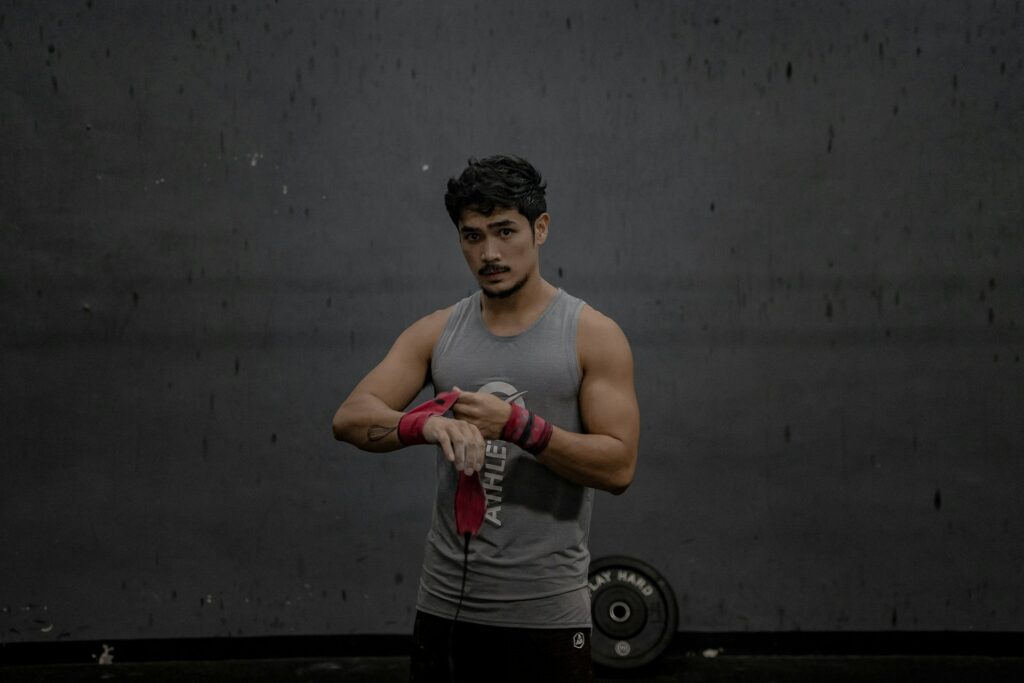
Beginner-Friendly Equipment and Plans
If you’re new to training, start simple:
- Resistance bands
- Adjustable dumbbells
- Jump rope
- Yoga mat
Follow beginner programs like:
- Starting Strength
- StrongLifts 5×5
- Bodyweight progressions
Focus on form, frequency, and building habits. You don’t need a full gym to start strong.
Intermediate Progressions
Ready to level up? Add:
- Barbell and plates
- Power rack
- Bench
- Kettlebells
Progress your programming with:
- Periodized strength plans
- Body part splits
- Conditioning circuits
Now is when tracking, variety, and structured rest become crucial.
Advanced Training Setups
Veteran lifters need:
- Specialty bars (trap bar, safety squat)
- Heavy-duty machines
- Cable systems
- Speed and agility tools
Advanced programming includes:
- Conjugate or Westside methods
- Olympic lifting cycles
- Custom hypertrophy blocks
You’ve got the tools—now dial in recovery, mobility, and precision.
Home Gym Safety Essentials
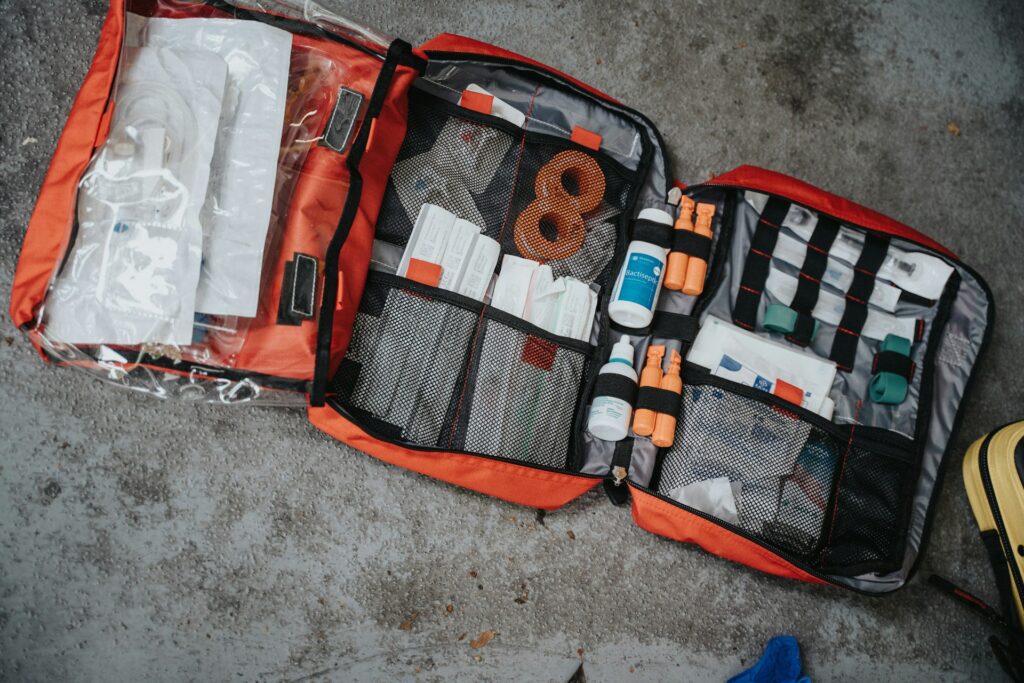
Proper Storage Solutions
Keep your gym clutter-free with:
- Vertical plate trees
- Wall-mounted racks
- Storage benches
- Rolling carts
A tidy space is a safe space.
Emergency Readiness
Keep these handy:
- First aid kit
- Fire extinguisher
- Emergency contact info
- Cell phone mount (in case you need help mid-set)
You may never need them—but it’s better to be prepared.
Injury Prevention Practices
Warm up, cool down, stretch. Use correct form. Don’t ego lift. Schedule deload weeks. Listen to your body.
Consistency beats intensity over time. Stay safe, stay sharp.
Conclusion
Building a home gym isn’t just about racks and weights—it’s about reclaiming your time, health, and control. It’s a space that evolves with you, supports your goals, and reflects your grit. Whether you’re just starting out or fine-tuning your setup, the journey begins with a single rep. Train smart, stay consistent, and turn that garage or spare room into the fortress of your transformation.
FAQs
How much should I spend on my first home gym?
Start with a $300–$500 budget. Focus on basics: dumbbells, bench, bands, and flooring. Expand as you grow.
Can I get ripped using just a home gym?
Absolutely. With consistency, proper diet, and progressive overload, home workouts can deliver serious muscle and fat loss results.
What’s the best way to stay motivated at home?
Track your progress, join online communities, set goals, and make your gym a space you love being in.
Is it safe to lift heavy without a spotter?
Yes, with the right safety gear. Use power racks with safety arms, maintain proper form, and avoid maxing out alone.
How do I maintain my home gym equipment?
Wipe down gear after use, oil moving parts monthly, check for loose bolts, and control humidity to prevent rust.






